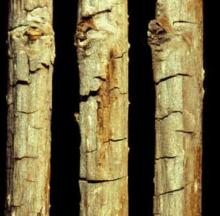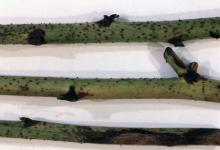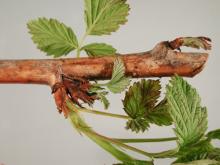See:
Raspberry Cultivar Susceptibility
Cause Xenodidymella applanata (formerly Didymella applanata), a fungus. The disease is found in western Oregon and Washington on red raspberry, 'Loganberry', and 'Youngberry'. The 'Willamette' cultivar of red raspberry is readily infected by spur blight but also is tolerant and can produce a satisfactory crop even if disease incidence is high.
From early April, mature black fruiting bodies (pseudothecia and later pycnidia) can be found in the gray affected areas of cane tissue. Pseudothecia discharge ascospores in wet weather and continuing until dry weather prevails (end of June). Ascospores infect leaves on fruiting-cane laterals and on emerging primocanes. Under very favorable conditions, the fungus may infect laterals and pedicels directly.
Symptoms Numerous brown necrotic spots (centered on veins) form on fruiting-cane leaves when rainy weather persists into late spring. Infected leaves become chlorotic and drop prematurely when the disease is severe. In contrast, infected primocane leaves develop brown V-shape lesions. The fungus then grows through the petiole to the cane and invades cane tissue around the bud, producing a brown-purple diseased area. Buds also may be reduced in size even if the fungus has not grown through the petiole. Buds on infected canes are more susceptible to winter injury, and fruiting laterals may be stunted. If the disease spreads along the canes (as in the Ashland, OR district) young canes turn brown up to 20 inches from the ground. Infected areas tend to turn gray in winter. Can be confused with cane Botrytis.
Cultural control
- Remove and destroy old fruiting canes after harvest.
- Keep plant rows narrow.
- Minimize or adjust irrigation so plants are not wet for long periods. Switch to drip/trickle irrigation.
- Practice good weed control.
- Control early primocane growth.
- Plant resistant or tolerant cultivars such as 'Meeker' or 'Willamette', respectively.
Chemical control
- Late dormant or delayed-dormant application.
- Rex lime sulfur (28%) at 6 to 12 gal/100 gal water. 48-hr reentry. O
- Spray at bloom or when new shoots are 8-to-10 inches long, then repeat 2 weeks later and after harvest to protect the foliage on fruiting canes and primocanes. A combination of both Captan (Group M4 fungicide) and iprodione (Group 2 fungicide) has been very effective in western Washington.
- Abound at 6 to 15.5 fl oz/A. Do not apply with silicone-based surfactants. May be applied on the day of harvest. Group 11 fungicide. 4-hr reentry.
- Bonide Captan 50 WP at 3 Tbsp/gal water can be used in home gardens. Washington only. Do not use within 3 days of harvest. H
- Cabrio EG at 14 oz/A. May be used at harvest. Group 11 fungicide. 12-hr reentry.
- Captan 80 WDG at 2.5 lb/A. Do not apply within 3 days of harvest. Group M4 fungicide. 48-hr reentry.
- CaptEvate 68 WDG at 3.5 lb/A. Do not apply within 3 days of harvest. Group 17 + M4 fungicide. 48-hr reentry.
- Elevate 50 WDG at 1.5 lb/A can be used even though pest is not on the label. Can be used up to and including the day of harvest. Group 17 fungicide. 12-hr reentry.
- Fontelis at 14 to 24 fl oz/A. Can be used day of harvest. Group 7 fungicide. 12-hr reentry.
- Iprodione-based products plus another fungicide with a different mode of activity. Can apply the day of harvest. Group 2 fungicide. 24-hr reentry.
- Meteor at 1 to 2 pints/A.
- Iprodione 4L AG at 1 to 2 pint/A.
- Rovral 4 Flowable at 1 to 2 pint/A.
- Pristine at 18.5 to 23 oz/A. Do not use with any other tank additive. Can be used day of harvest. Group 7 + 11 fungicide. 12-hr reentry.
- Quadris at 6 to 15.5 fl oz/A. Do not apply with silicone-based surfactants. May be applied on the day of harvest. Group 11 fungicide. 4-hr reentry.
Reference Martin, R.R., Ellis, M.A., Williamson, B., and Williams, R.N. 2017. Compendium of Raspberry and Blackberry Diseases and Pests. 2nd edition. St. Paul, MN: APS Press.




